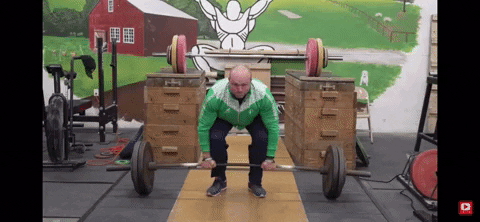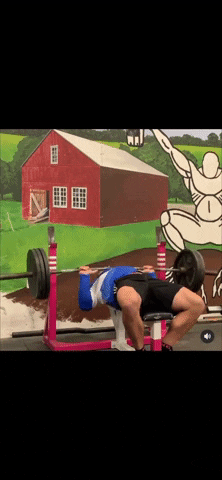How Strong Is Strong Enough?

How Strong Is Strong Enough?
In its simplest form, strength is the ability to apply force to an opposing object or even into the earth. We can think about how strength is related to power development, jumping ability, speed, absolute strength, and hypertrophy work where we want to increase the size of the musculature structure and then enhance the innervation capability. In reality, if we dumb it down, strength comes back to how much weight an athlete can bench, clean, or squat.
So when we are talking about strength and being strong in the weight room, we have to discuss athletic capability and what the sporting needs are. Typically we have to break it down into two aspects. One aspect revolves around open-skill sports. Open skill athletics contain unplanned movement patterns. Football, basketball, lacrosse, soccer, and other sports are not repetitive with a lot of unplanned movements taking place. That is where chaos coordination comes into play. There is a large amount of force needed to execute moves in different open-skill sports, as well as a large amount of mobility needed to execute proper movement patterns.

That then leads us into closed skilled sports. Closed skilled sports are repetitive and pre-planned. A 100-meter sprint, a shot put throw, and the snatch and clean and jerk in weightlifting are all examples of closed skilled sports. Instead of chaos coordination, closed skill sports have chronic coordination. This means there will be consistent issues and tendencies that need to be trained for and that need to be prevented from leading to injuries that occur in closed skilled sports. Closed skill sports are much more predictable than the chaotic coordination within open skill sports.
Strength is also related to injury prevention, especially when we start to identify problem areas with the rate of speed. Think about the elbow for a tennis player or the shoulder for a shot putter.

Another large part of strength training is identifying the opposition and the load of the opposition being faced. For football, athletes have a heavier opposition with a high load. For tennis or badminton, the opposition is the racket and the perception of the opponent’s movements. For baseball, it will be the ball or a weighted bat. In wrestling, the opposition will be a heavy load that is constantly opposing the athlete’s forces. With shot putting and discus, the opposition is the athlete’s body weight and the implement being thrown.

From there, we can take all the above information and break it down into open skill sports with light opposition, like tennis, or open skill sports with heavy opposition, like football or wrestling. We can go into closed skill sports with heavy opposition, like weightlifting, or closed skill sports with light opposition, like football or throwing. Once the sport is typed, we can decide if we are training solely for injury prevention or chaos coordination.
We need to analyze individuals within sports trends. Going to closed skilled sports, we know that most throwers that rotate a lot will have lower back pain on their non-dominant side and that most pitchers will have shoulder or elbow pain because of a significant load on the shoulder and elbow. We need to identify that with the strength development in the weight room.
We also know what specific movements will transfer well to the sport being trained for, open or closed skill. Identify how much the sport being trained for needs technical coordination work, absolute strength work, hypertrophy work, plyometric work, or reflexive work to improve overall performance while also mitigating exposure to injury.
Establishing the baseline numbers is key. Thinking about sports with light opposition, the first thing we have to do (with men) is train the athlete to have the ability to clean the equivalent of bodyweight. For women, cleaning bodyweight would be phenomenal as well. With the back squat, we want men to hit at least 1.5x bodyweight and women to hit 1.25 to 1.4x bodyweight. With pull-ups, we want women to do 5 to 7 reps and men to be able to bust out 10 pull-ups. For the bench press, we want women to do bodyweight or slightly below with men doing bodyweight to 1.25x bodyweight.
For heavy opposition sports, like football and wrestling, we want our men to be able to squat 2x bodyweight and women to squat 1.5 to 1.75 bodyweight. With pull-ups, we want men to rep out 10 to 20 pull-ups and women need to reach double digits from a dead hang. For the bench press, men need to hit 1.75x bodyweight or higher; for women, 1.25x bodyweight is the goal. For the clean, men need to hit 1.6x bodyweight and women to hit 1.25x bodyweight.

Recap
Aforementioned, we want over the simplest terms of strength-based training and how strength can help performance. We know strength can improve jumping ability, speed, absolute strength, relative strength, technical coordination, and reflexive strength. Having the baseline benchmarks gives athletes goals to work towards. Remember, typically sports with light opposition don’t need as much strength compared to sports with heavier opposition (unless we are talking about throwing).
Related Posts
Blog Topics

Yo, It's Dane
Welcome to the Garage Strength Blog, where it is my goal to provide you with the experience and knowledge I've gained in the strength and conditioning world over many years of learning from both successes and failures. I train elite-level athletes in a multitude of sports from the high school to professional levels, already producing 5 Olympics and 30+ National Champions. If you want to be the next champion I train, check out my strength programs below!


